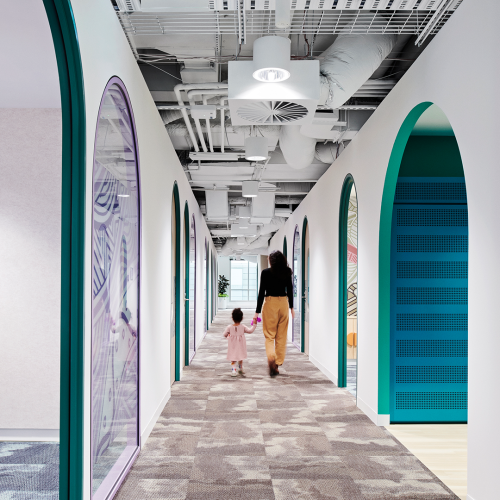Hames Sharley Melbourne Studio
- Client:
- Hames Sharley
- Location:
- Wurundjeri Country; Melbourne, Victoria
- Awards:
-
Dulux Colour Awards - Finalist - 2024
Australian Interior Design Awards - Shortlist - 2024
- Credits:
-
Alex MacDonald
Pavel Ornelas
Kate McCann
Sonja Duric
The Hames Sharley Melbourne studio represents a bold new shift in our practice towards sensory and energy-based design; this is a workplace that celebrates divergent thinking and the core philosophy of creativity through feeling, transforming a once-static office into an adaptive space that allows our people to flourish.
Situated on the third level of an Art Deco, modern gothic building from the 1930s, we sought to honour its history wherever possible. The interior is informed by the strong structural grid inherited from the Art Deco period, with walls situated to mirror the columns that align with the window alcoves, without requiring significant structural work. Boomerang-shaped chairs and furniture echo the shape of the alcove windows, and the original steel windows peer into the treetops lining Collins Street.
The main studio space spans the entire length of the floor plate, with guests entering into a collaborative zone, featuring a ‘maker space’ that celebrates the explorative and tactile nature of our creative design studio.
From there, we configured the layout as an energy map with high-intensity, active spaces near the entry through to low-intensity, quiet spaces at the opposite end, allowing the team to ‘dial up’ or ‘dial down’ their level of interaction to suit their sensory needs on any given day.

With the objective of being carbon-neutral, the studio showcases materials that promote regenerative design. The original structural clay tiles in the ceiling were exposed and retained – their terracotta colour informing the interior palette and material selections, including sustainable (and carbon negative) cork walls and floors throughout. Flat-packed furniture was specified for its innovation or heritage qualities, e.g. Thonet Le Corbusier Chairs (designed when the building was designed). ‘Path’ task chairs by Humanscale were specified for their high sustainability. The approach enables a ‘light touch’ to the space and allows the team to move things around effortlessly and reconfigure the space at will.

The build occurred post-COVID, during a difficult economic period of high costs which were mitigated by procuring the project in different ways, such as sustainably sourcing furniture and crockery from local op-shops, not using a traditional build and procuring some trades and products directly from suppliers. We sought to champion pioneering female designers and local Australian furniture designers, suppliers and artisans, including supporting First Nations peoples.
Our high-energy communal space is designed to welcome the Melbourne community, whether it be for design workshops, kid’s modelmaking workshops, or industry events.
As a result, our people are more collegial and collaborative and have become custodians of the space. It sparks their creativity and enables them to do what they do best, which has the flow-on effect of furthering design excellence within the broader industry.















